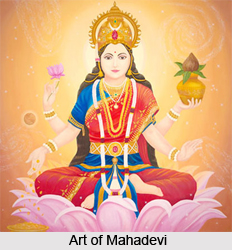 Theory of Creation in Tantrism accentuates the union of Lord Shiva and Shakti. The Supreme is at once niskala and sakala. The Sakti of Brahman is eternal and inseparable. This Sakti is with and without attributes that is Sakti is both Nirguna and saguna. In her aspect of goddess in the form of consciousness, she manifests the being, and through her as the goddess in the form of bliss Brahman manifests Himself.
Theory of Creation in Tantrism accentuates the union of Lord Shiva and Shakti. The Supreme is at once niskala and sakala. The Sakti of Brahman is eternal and inseparable. This Sakti is with and without attributes that is Sakti is both Nirguna and saguna. In her aspect of goddess in the form of consciousness, she manifests the being, and through her as the goddess in the form of bliss Brahman manifests Himself.
Sakti is imminent in universe. By characterizing the goddess as constituted by the basic mantra her subtle body is referred to Siva which is wrapped in the web of Maya and the latent satisfaction is fancied as the supreme Bindu. Bindu is circular that is bounded by the border of Maya. Brahman, the abode of Prakrti-Purusa is in the centre of Maya. Bindu is Prakrti-Purusa; Sabda-Brahman or Apara-Brahman. The goddess becomes inclined to Siva due to the union of Siva and Sakti. Then the creation proceeds. However the relationship of Siva and Sakti is controversial.
Sabda-Brahman manifests itself in three Shaktis - knowledge, desire and action. The goddess is considered as icchasakti, jhanasakti, kriyasakti and svarupini. Terms like svatantrata, nitya, nitya-tripta, sarvajnata convey the completeness of Siva. From Paramasiva arises Sambhu, from Sambhu Sadasiva, from Sadasiva Isana and with their own Shaktis arise Rudra, Vishnu and Shiva. In the Mahanirvana-tantra, Siva has been addressed as Sambhu, Sadasiva, Mahesvara and so on. All these are names of different conditions and manifestations of Siva.
Shakti is simultaneously the form of Maya and Mulaprakrti. Through the power of Maya, Brahman conceals his original form and appears in different forms. Mulaprakrti is not apparent. She resides in the universe consisting of various names and forms in a manifested state. Siva-Sakti dwells in the muladhara and Kundalini within the human body itself. Sabda-Brahman resides in the form of Kundalini and is manifested as aksharas in all processes.
Shakti is termed as Maya, Mahamaya, Devi, Prakriti and so on. She is Vidya and Avidya. As Avidya she causes bondage and as Vidya she puts an end to rebirth thereby giving liberation. She is called Adya Sakti as she is believed to have existed before creation. Atman is to be conceived as Devi. Shakti is only a manifestation of Shiva in the form of mother. As Para Brahma, Devi is beyond form and quality. She has been conceived: supreme form who is beyond knowledge, delicate body constituted by mantra; this unformed aspect is beyond meditation and the gross body which is easily comprehensible.
As Mahadevi, Sakti exists in different forms like Sarasvati, Lakshmi, Durga and Annapurna. As Sati she is the consort of Lord Siva. When Sati surrendered her body Siva carried the dead body. Lord Vishnu with his disc cut the body to 51 pieces which were dropped at different places which were called Mahapihasthanas. At each of these places Devi along with her Bhairava is worshipped. She resides in all the animate and inanimate objects of the universe.
Shakti resorts to Siva always. Her first appearance is with the release of the universe. Prior to this Shakti is dormant in Shiva. This attribute less state is known as Sunya in Shaiva Agamas and it is beyond comprehension. It is so called as it is beyond all meanings.




















